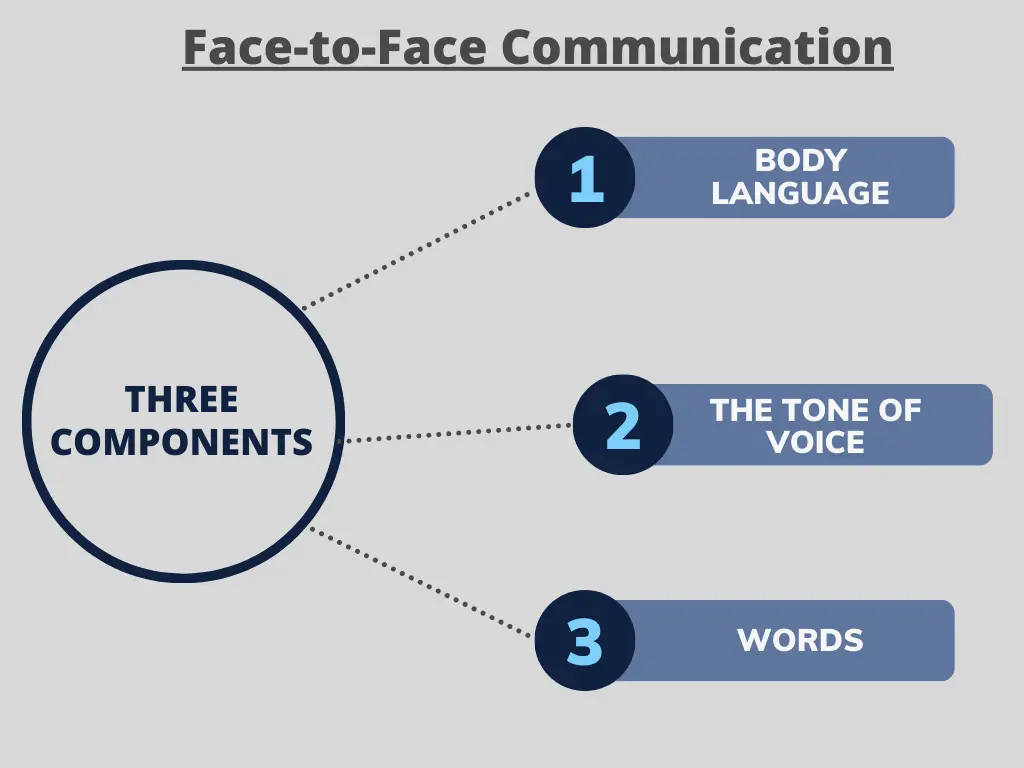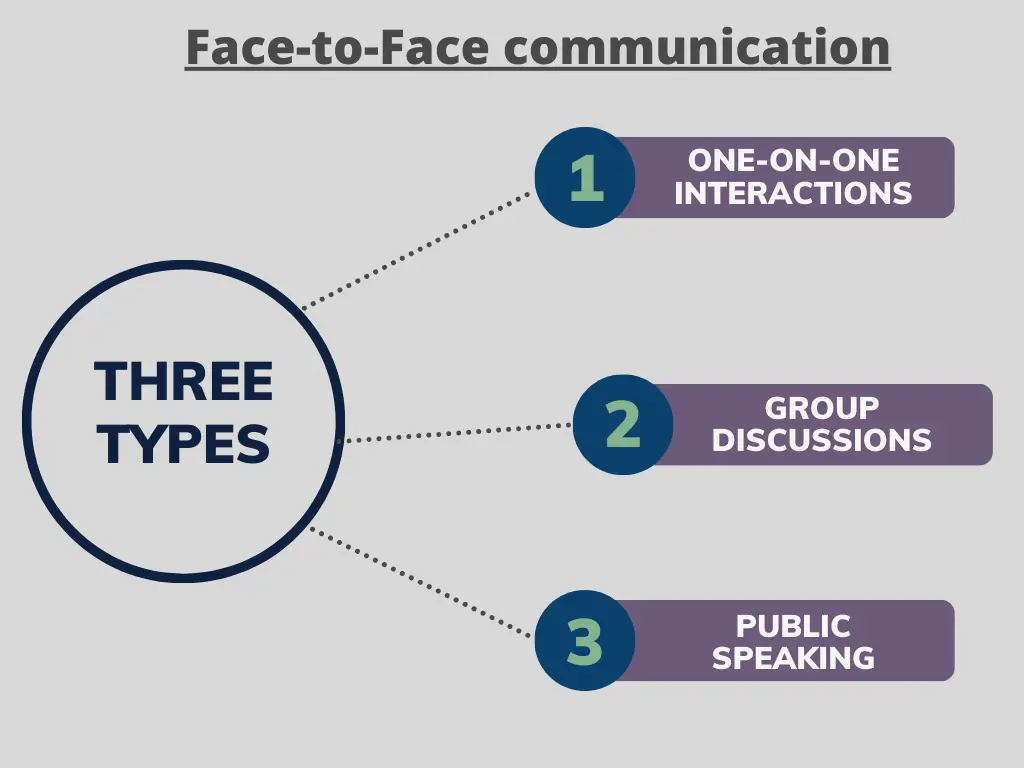In today’s digital ecosystem, face-to-face communication still stands as a critical pillar for genuine human interaction. Despite the convenience of electronic communication, the connection experienced during in-person conversations remains unmatched.
This blog explores the significance of face-to-face communication, highlighting its ability to establish trust, express emotions, and cultivate meaningful relationships in personal and professional settings.
What is the meaning of face-to-face communication?
Face-to-face communication is the process of exchanging information and conveying messages through direct personal interaction. Unlike digital conversations, it involves not only the verbal exchange of words but also non-verbal cues such as facial expressions, hand gestures, and posture.
This form of communication is often more effective because it allows for immediate feedback, ensuring a clear understanding between participants and facilitating a genuine connection that builds trust.
Why face-to-face communication is important in business
Face-to-face communication holds significant importance in business for several reasons:
1/ Enhanced Relationship Development:
Being physically present in business interactions allows for meaningful face-to-face connections, promoting a sense of trust that is vital for establishing mutually beneficial business relationships.
This personal touch enables a deeper understanding of each other’s perspectives, promotes effective communication, and facilitates the building of long-lasting connections based on mutual respect and shared goals.
2/ Efficient Problem-Solving:
When dealing with complex issues that require deep analysis and critical thinking, in-depth discussions and real-time feedback play a pivotal role. Face-to-face interactions offer a unique advantage in providing these elements.
By being physically present in the same room, team members can not only exchange ideas but also read non-verbal cues and engage in improvised collaboration. This encourages a more effective brainstorming process and facilitates collective problem-solving, leading to stronger team alignment.
3/ Accurate Information Exchange:
Accurate information exchange is crucial for effective communication. When numbers and data are shared in person, there is a lower chance of misunderstanding. Research has shown that face-to-face interactions lead to a more precise understanding and interpretation of results.
This is because non-verbal cues can provide additional context and clarity. So, when it comes to exchanging important information, opting for in-person communication can greatly enhance accuracy and clarity
4/ Building a Cohesive Team:
Face-to-face communication is of utmost importance for effective team building. It provides a unique opportunity for trust to be established and deep bonds to be formed among colleagues.
Through direct interaction, team members can not only convey their ideas and thoughts more clearly but also pick up on non-verbal cues that are crucial for building strong working relationships. These personal connections nurture a sense of harmony and understanding, resulting in a more united and efficient team.
5/ Conflict Resolution:
Face-to-face conversations provide an invaluable opportunity for employees to openly and respectfully address conflicts, allowing for a deeper understanding of each other’s perspectives. This direct approach not only leads to faster resolutions but also develops stronger relationships built on trust and empathy.
6/ Conveying Passion and Engagement:
Attending meetings in person can demonstrate dedication, excitement, and involvement in a manner that digital interactions might lack, thus leaving a deeper impression on those involved.
What are the 3 components of face-to-face communication?
Effective face-to-face communication relies on the integration of three key components: body language, voice, and words. Each element plays a vital role in conveying messages with clarity and impact.

1/ Body Language:
Body language encompasses the non-verbal cues we employ to express meaning and emotion. It includes a wide range of physical movements, expressions, and postures offering valuable insights into an individual’s thoughts, feelings, and intentions.
2/ The Tone of Voice:
The tone, volume, and inflection of our voice can substantially influence how our message resonates and is understood. While the actual words we use are essential, they are only a small part of effective communication.
Our vocal delivery can convey distinctions that words alone cannot express, such as excitement, sincerity, or sarcasm. By paying attention to our voice and actively adjusting it in real time, we can create a more engaging and impactful conversation.
3/ Words:
In face-to-face communication, the way we speak and the words we choose play a crucial role. Our words have the power to convey detail, evoke emotions, add humor, or demonstrate politeness. However, they are most effective when they are both authentic and aligned with the individuals we are conversing with.
The words we carefully select serve as the medium through which our message reaches its intended recipients, making it critical to choose them thoughtfully and with the utmost consideration.
3 types of face-to-face communication
Face-to-face communication incorporates various types, each serving different purposes and occurring in different contexts. Here are some common types of face-to-face communication:

1/ One-on-One Interactions:
Personal meetings where two individuals engage in direct conversation, facilitating a private and focused exchange of thoughts, ideas, or information. These interactions provide an opportunity for deep connection and understanding between the participants. Whether it’s a mentorship session or a coaching session, one-on-one interactions allow for personalized attention and tailored communication.
2/ Group Discussions:
These involve multiple participants and can range from formal meetings to informal gatherings, allowing for a broader exchange of views and collective brainstorming. Group discussions create a dynamic environment where diverse perspectives and insights can be shared. It encourages collaboration and the exploration of different ideas. From team meetings to collaborative problem-solving sessions, group discussions encourage teamwork and synergy among participants.
3/ Public Speaking:
This includes presentations and speeches delivered to an audience, where the speaker conveys a specific message or information to inform, persuade, or entertain the listeners. Public speaking is an art that requires effective communication skills, confidence, and the ability to engage the audience. It can take various forms, such as delivering a keynote address, giving a TED Talk, or presenting at a conference.
Face-to-face communication examples
Here are some common examples of face-to-face communication:
Job Interviews: During a job interview, a candidate and interviewer engage in a face-to-face discussion to evaluate the candidate’s skills and experience, determining their suitability for a particular position.
Client Pitch Meetings: Crucial for businesses aiming to secure a deal, these meetings involve presenting proposals and demonstrating the value of the business in person. They provide an opportunity for immediate interaction and the ability to convincingly convey passion and dedication.
Sales Demonstrations: These are direct interactions with potential customers, where products or services are presented. The goal is to demonstrate the benefits and address any questions in real time, thereby facilitating the sales process.
Community Forums: These public gatherings provide a platform for citizens to actively participate in discussions with local leaders, addressing community issues and expressing their opinions on matters that impact their shared environment.
Customer Service Encounters: Instances where service staff interact with customers to address their needs, handle complaints, or offer assistance. These interactions are often critical in shaping the customer’s perception of the business.
What are the advantages of communicating face-to-face?
Communicating face-to-face offers numerous advantages that contribute to more effective, meaningful, and impactful interactions. Here are some key advantages:
1/ Immediate and Complete Understanding: Engaging in face-to-face interactions frequently results in a comprehensive and instant grasp of the topic at hand. This is facilitated by the joint communication of both verbal and non-verbal signals.
2/ Enhanced Problem-Solving: Direct interactions, such as face-to-face discussions or real-time collaboration, create an environment conducive to dynamic problem-solving. This kind of setting allows participants to engage in immediate problem resolution, encouraging quick responses and effective solutions as issues arise.
3/ Immediate Feedback: In-person communications provide the advantage of immediate feedback, allowing for real-time evaluation and adjustment. This enables faster decision-making and more efficient problem-solving, as concerns can be addressed and resolved promptly. By facilitating direct interaction and quick response, immediate feedback enhances collaboration and ensures effective communication between individuals or teams.
4/ Emotional Intelligence: Face-to-face interaction enables individuals to perceive and interpret the emotions of others, enhancing the quality of the conversation and leading to stronger, more empathetic relationships.
5/ Cultural Competence: Direct interaction, whether through face-to-face conversations, collaborative projects, or cultural exchanges, plays a pivotal role in building a deeper understanding of cultural details. This understanding not only enhances communication effectiveness but also cultivates an environment of mutual respect and appreciation for diverse perspectives.
6/ Higher Persuasion Potential: Persuading and influencing others is often more powerful in person, where verbal fluency, body language, and emotional intelligence work together to make a significant impact.
What are the disadvantages of face-to-face communication?
1/ Logistical Challenges: Organizing face-to-face meetings can be quite challenging due to various factors such as conflicting schedules, the need for travel, or the geographical distances that may separate participants. These factors often pose hurdles and can make it harder to bring people together physically.
2/ Limited Recordkeeping: In-person conversations, unlike written communication, may not always result in written records or minutes of the meeting. This can make it more challenging to recall and refer back to specific points, agreements, and decisions made during the discussion. This limitation can potentially prevent clarity and accountability in the future.
3/ Cultural Barriers: Face-to-face communication can be affected by cultural differences, such as language barriers or varying non-verbal cues. However, these challenges can also present opportunities for learning and understanding different cultures through effective communication practices.
4/ Time-Consuming: In-person interactions typically demand a greater investment of time when compared to digital communications. This includes factors such as travel, preparation, and the duration of the meeting itself.
5/ Pressure and Anxiety: Face-to-face communication can be intimidating to some individuals, potentially impacting the natural flow and desired outcomes of the conversation due to the presence of performance anxiety. This psychological state of unease can arise from various factors such as the fear of judgment, the pressure to articulate thoughts effectively, or the concern of making a good impression.
Further Reading: What are face-to-face communication’s advantages and disadvantages
Why is face-to-face communication better than online communication
Face-to-face communication is often considered superior to online communication for several compelling reasons. Firstly, it cultivates genuine human connections. When individuals meet in person, they engage in a level of personal interaction that cannot be replicated online. This connection can lead to stronger, more trusting relationships.
Secondly, non-verbal cues such as hand movements, facial expressions, and posture play a vital role in communication, providing additional context that virtual communication lacks. These cues help convey emotions and intentions, enhancing the dialogue.
While online communication is convenient, it may result in misunderstandings as it lacks these non-verbal elements. In contrast, face-to-face meetings allow for quicker problem-solving and decision-making, as participants can address issues in real time. Moreover, personal meetings offer greater privacy, reducing the risk of interceptions or leaks during sensitive conversations.
Despite the advantages of digital tools, they cannot provide the same level of engagement and personal touch as face-to-face interactions, emphasizing why in-person communication is often an effective exchange.
Does social media affect face-to-face communication?
As social media increasingly intertwines with modern social interaction, its impact on face-to-face communication is significant and diverse. Social media platforms can enhance personal interactions by maintaining connections across distances, which helps sustain relationships.
It serves as a link, allowing for a continuous exchange of ideas, emotions, and experiences, keeping the line of communication in the absence of physical closeness.
Therefore, social media can be a complementary tool for enhancing and sustaining relationships, but its overuse can diminish the authenticity and immediacy that only face-to-face communications can provide. Maintaining a balance is essential, requiring a thoughtful approach to how social media influences our personal and professional environments.
Tools for face-to-face communication
Tools for face-to-face communication typically involve technologies that facilitate real-time interaction between individuals who are physically present in the same location. Here are some common tools used for face-to-face communication:
- Video Conferencing Platforms: Well-known software like Zoom, Microsoft Teams, and Skype have gained extensive acceptance. They allow businesses and individuals to conduct virtual meetings that Imitate the experience of being together in person.
- Virtual Reality (VR) Meetings: VR technology is leading the path towards engaging meetings, allowing participants to interact as avatars in a three-dimensional virtual setting.
- Smart Glasses and Augmented Reality (AR): Google Glass and similar devices enable users to participate in hands-free video calls while incorporating crucial information within their line of sight.
- Mobile Devices: Smartphones and tablets with front-facing cameras have made immediate face-to-face communication accessible anywhere and anytime.
Ways to improve face-to-face communication skills
Improving face-to-face communication skills is beneficial for personal, professional, and social interactions. Here are some effective ways to enhance these skills:

- Active Listening: Develop active listening by maintaining eye contact, nodding, and responding appropriately to demonstrate understanding and attentiveness to the speaker.
- Empathy and Emotional Intelligence: Nurture empathy by actively listening and emotionally tuning into the conversation partner’s feelings and perspectives. This deep level of engagement can significantly enhance mutual understanding, strengthen connection, and create a more supportive and empathetic communication environment.
- Clarity and Conciseness: Aim for clarity by articulating thoughts clearly, avoiding jargon, and ensuring that the core message is not lost in excessive details.
- Open-mindedness: Approaching conversations with an open mind involves being willing to listen actively, consider alternate perspectives with genuine curiosity, and warmly welcome new ideas and insights. This approach develops a dynamic exchange of thoughts and promotes a deeper understanding of diverse viewpoints.
- Feedback: Encourage and offer constructive feedback to enhance communication practices and resolve misunderstandings effectively.
- Context Awareness: Be mindful of the cultural specifics and situational circumstances present during communication. It is crucial to adjust your approach to align with the specific dynamics of each interaction, taking into consideration factors such as language, traditions, and individual preferences.
- Nonverbal Communication: Develop expertise in interpreting and communicating through body language. Acknowledge that gestures, facial expressions, and posture play a crucial role in conveying messages effectively.
Incorporating these strategies into daily interactions will not only enhance personal and professional relationships but will also lead to more successful face-to-face communication outcomes.
Frequently Asked Questions
Q1) What are face-to-face types of communication?
Ans: Face-to-face communication refers to instances where individuals interact directly with one another, without the mediation of digital devices. There are several types of face-to-face communication such as One-on-One conversations, group discussions, interviews, and presentations These face-to-face communication types facilitate diverse social and professional interactions, enabling individuals to build connections, resolve conflicts, and share ideas effectively.
Q2) What is face-to-face communication in a team?
Ans: Face-to-face communication in a team refers to direct, in-person interactions among team members within a professional setting, facilitating real-time dialogue and collaboration. This form of communication is essential for building trust, encouraging team cohesion, and enabling immediate feedback and problem-solving.
Q3) Is face-to-face a type of verbal communication?
Ans: Yes, face-to-face communication is a type of verbal communication as it involves the use of spoken words for the exchange of information between individuals. In this form of communication, words are enhanced by a variety of supporting elements such as intonation, facial expressions, physical movements, and postures. These cues have the power to strengthen or modify the spoken message.
Q4) Is face-to-face a two-way communication?
Ans: Yes, face-to-face communication is fundamentally a two-way interactive form of communication. It involves a reciprocal exchange of information where both participants play active roles as senders and receivers of messages.



